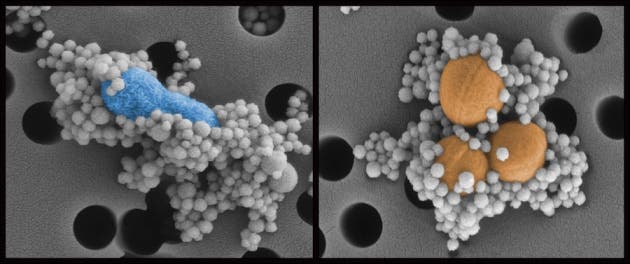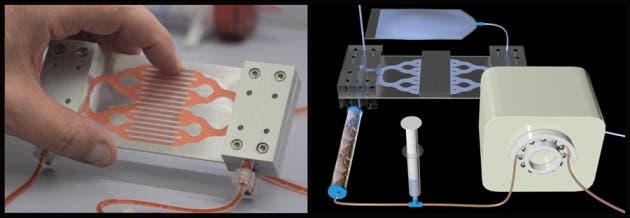
Magnetic nanobeads in the ‘biospleen’ device bind to Escherichia coli (left) and Staphylococcus aureus (right) and remove them from blood. Harvard’s Wyss Institute
Researchers have developed a device which can clean the blood in the body of virtually all infections – even those which they don’t know about. The device, which was heavily inspired from the human spleen can clean the blood of everything from E. coli to Ebola.
The spleen is an organ that appears in all vertebrates, acting basically as a blood filter. However, while the spleen is very effective at fighting off most blood infections, there are some which it cannot defeat. Those blood infections are extremely dangerous and can become septic; most cases are treated with large spectrum antibiotics – but that approach is not always effective.
Another (long term) problem with antibiotics is that they can kill most, but not all the bacteria – thus helping the remaining ones develop resistance to the drug. Specialized antibiotic would work much better, but the problem is that in over 50% of cases, physicians can’t accurately diagnose the cause of the infection. In search of an alternative, a team led by Donald Ingber, a bioengineer at the Wyss Institute for Biologically Inspired Engineering in Boston, Massachusetts, developed an artificial ‘biospleen’ which can filter out blood, cleaning it of any potential infection – even if you don’t know what it is.

The ‘biospleen’ uses protein-equipped nanobeads and a magnet to cleanse blood of pathogens. Harvard’s Wyss Institute
The device uses a modified version of mannose-binding lectin (MBL) – a protein which occurs naturally in humans that binds to sugar molecules on the surfaces of more than 90 different bacteria, viruses and fungi. It also binds to the toxins which bacteria release when they are killed – it’s these toxins that trigger the immune overreaction in sepsis.
So far, they tested the device on rats; they infected the rats with E. coli or Staphylococcus aureus and filtered blood through the biospleen. After only 5 hours, 89% of the rats whose blood had been filtered were still alive, compared with only 14% of those that were infected but not treated. Researchers found that the device removed over 90% of the bacteria from the blood, also reducing inflammation in the internal organs.
They then tested the device to see if it could work on larger volumes of blood – like the 5 liters that humans have on average. They ran human blood through the biospleen at a rate of about 1 liter per hour and found that the device removed most of the pathogens within five hours. That rate is probably enough to cure most blood infections, even severe ones. Ingber is very confident in says that the biospleen could help treat even viral diseases such as HIV and Ebola. The group is now testing the device on pigs, and if that works out fine, then human trials will start soon.









